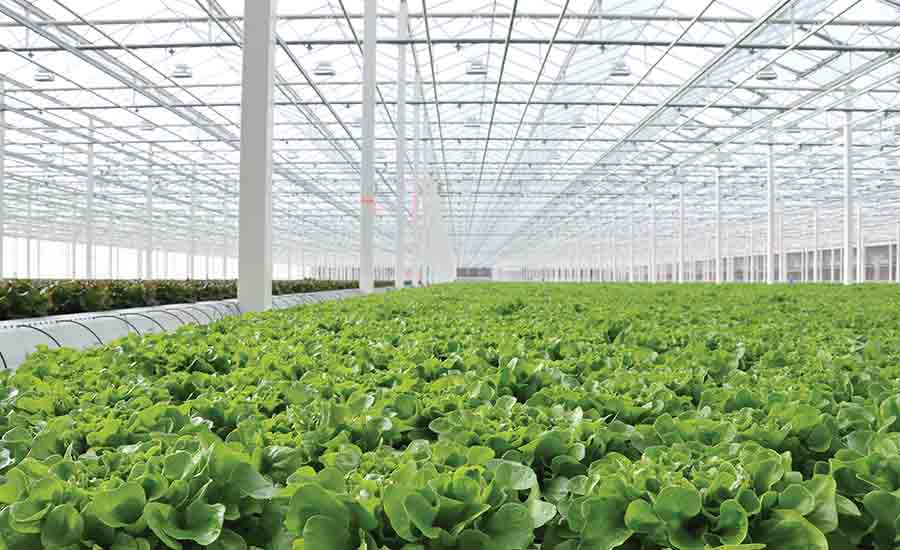Disruptive innovation” is said to shake up years of subtle stagnation in the food industry, according to a report published by Packaged Facts, Rockville, Md. New players will shake up the status quo, local start-ups will provide locally grown produce, authenticity will drive innovation and health and wellness will continue to lead the way.
Meanwhile, incubators and private investment firms are investing in agriculture to expand access to sustainable goods.
Likewise, Industrial Internet of Things (IIoT) technologies such as Big Data analytics and artificial intelligence (AI) are expected to play a huge role in accelerating and streamlining the manufacturing process through advanced automation and analytics, according to a study produced by Frost & Sullivan, Santa Clara, Calif. And, the global demand for food products continues to lead equipment manufacturers to acquire, merge and partner with companies to leverage technology innovation.

Tyson Foods partnered with Achates Power to pilot two emerging motor technologies to improve fuel efficiency, reduce carbon emissions and conserve energy.
That’s why companies like Albertsons, Tyson Foods, Living Greens Farm and more are implementing sustainable practices across their network of manufacturing facilities.
Improving fuel efficiency one fleet at a time
Tyson Foods, Springdale, Ark., is always looking for ways to reduce its carbon footprint, while improving efficiency and lowering cost.
For example, in 2017, it collaborated with the World Resources Institute (WRI), Washington, D.C., to establish a new “30 by 30” target, where WRI develops science-based greenhouse gas (GHG) and outcome-based water conservation targets for Tyson Foods’ operations and supply chains. The goal is to reduce greenhouse gases (GHG) 30% by 2030.
“Our greenhouse gas reduction target includes emissions from our direct operations as well as our entire value chain,” says Rob Lyall, vice president of transportation. “For us, this includes everything from the grain that is fed to livestock to the energy used to sell our protein products in grocery stores and through foodservice operators.”

Albertsons partnered with Takeoff Technologies to become what is said to be the first national grocer to implement an automated e-commerce fulfillment solution.
Last year, Tyson Foods partnered with Achates Power, San Diego, Calif., to pilot two emerging motor technologies to improve fuel efficiency, reduce carbon emissions and conserve energy. Here, Tyson’s fleet is testing the Opposed Piston-powered Peterbilt 579 tractor engine in a company truck that serves customers in California.
“The Achates Power engine utilizes opposed piston technology that has yielded up to 90% reduction in nitrous oxide as well as increased fuel economy,” says Lyall. “This technology allows for a smaller displacement engine with similar performance as the larger engines, all while cutting fuel cost and emissions.”
Likewise, Tyson Foods piloted the Kalmar Ottowa all-electric yard tractor by Kalmar Global, Finland, at its Northwest Arkansas distribution center.
“Kalmar Ottowa electric yard tractor utilizes only electric motors to power the entire unit,” adds Lyall. “Adoption of electric-powered units lead to reduced emissions and overall efficiency of the equipment. By adopting the most dependable equipment possible, our supply chain can operate more seamlessly.”

Living Greens Farm is said to become the largest vertical plane aeroponic farm in the world.
Aeroponic farming for sustainable produce
While aeroponics has been around for decades, Living Greens Farm, Faribault, Minn., discovered a way to transition and improve this technology for commercial production, and is now said to become the largest vertical plane aeroponic farm in the world, says Dana Anderson, founder and CEO.
That’s because the company’s patented vertical plane design allows one acre to produce the equivalent of hundreds of conventional acres, producing 20 pounds of produce every 30 days, equaling approximately 90,000 plants per year. And, earlier this year, Living Greens Farm announced plans to open a third grow room, bringing the farming operation to 60,000 square feet.

Wasatch Resource Recovery built what is said to be Utah’s first anaerobic digester for food waste, diverting food waste from landfills to produce enough natural gas for a city the size of Bountiful, Utah.
“Living Greens’ patented design reduces nozzles by over 99%, making it easier to grow larger amounts of produce,” says Andersen. “[And], harvest is less than 21 days for a head of lettuce, which is about two times faster than traditional farming. As a result, the process is operationally efficient, as farmers can harvest 4-5 more cycles annually.”
Living Greens’ high-tech computer system manages the plants’ growing conditions for variables such as light, temperature, humidity and CO2 to grow year-round produce. Using a patented system, the farm grows lettuce, herbs and microgreens in the air instead of soil, so it never comes in contact with most common contaminants.
“There’s strong potential for this technology to be applied to other types of produce,” says Anderson. “For example, aeroponics has already been modified for growing potatoes. We’re always looking for opportunities to expand our offerings, but once our new farm is fully functional and the new product line has been launched, we plan to shift our focus to this initiative.”

Spread Co. opened Techno Farm Keihanna, what is said to be the largest automated vertical farm in the world.
Automated e-commerce fulfillment solutions
In November 2018, Albertsons Cos., Boise, Idaho, partnered with Takeoff Technologies, Inc., Waltham, Mass., to become what is said to be the first national grocer to implement an automated e-commerce fulfillment solution.
“Albertsons Cos. is utilizing space in existing stores to build Takeoff’s ‘hyper-local’ automated fulfillment centers,” says Narayan Iyengar, senior vice president of digital and e-commerce. “The machine will be replenished daily, much like store shelves. A customer will enter an order using the existing e-commerce interface, and the automated system processes it. Artificial intelligence-enabled technology using totes and conveyors will deliver the items to an Albertsons employee, who will prepare the order for the customer. AI will allow Albertsons to fulfill orders in a more streamlined manner that makes it easier for our employees to pick orders. Product selection is enhanced by automation, increasing productivity by 10 times.”
Additionally, Albertsons has implemented a number of green/sustainable solutions and technologies company-wide.
For instance, Albertsons replaced fluorescent lights in refrigerated and frozen cases of about 500 stores to LED lights that use 70% less energy and offer a longer lifespan. This is part of an ongoing program to reduce energy consumption in lighting throughout the store, according to Victor Muñoz, senior manager of energy utilization.
Albertsons upgraded shaded pole case fan motors in refrigerated cases to electrically commutated motors (ECM), which use about 70% less electricity and last three times longer.
Albertsons also installed anti-sweat heater controls on frozen food case doors to keep condensation from forming on the door and dripping water onto the floor.
“With the controls, the heater works only when the door begins to sweat, rather than 24 hours a day,” adds Muñoz. “The controls not only reduce energy consumption, but also improve the efficiency of the unit and reduce the safety hazards associated with water dripping on the floor.”
The grocery retailer also installed walk-in box door alarms for backroom walk-in freezers.
“It sounds an alarm and notifies the alarm company when the freezer door is left open,” says Muñoz. “The notification helps the store reduce energy consumption and prevents ice from forming on the freezer’s evaporator coils, a problem that diminishes the freezer’s performance.”
Albertsons also installed doors on medium-temperature refrigerated cases of yogurt, cheese and cold cuts, as well as in the deli area to make for a more comfortable-temperate shopping environment.
Producing ultra-clean produce year-round
Last year, Whole Leaf, Canada, announced plans to double the size of its state-of-the-art Alberta, Canada, facility, making it what is said to be the largest lettuce greenhouse operation in North America dedicated to growing ultra-clean Canadian lettuce year-round.
“The additional 5 acres of growing space will include a next-generation climate chamber designed to better maximize the requirements for each specific type of lettuce in the Inspired Greens assortment. This will result in better quality, longer shelf life and more consistent plants for retailers and consumers,” says Rindi Bristol, director of sales. “The expanded acreage will include several of the features in the original design, including the NFT hydroponic system, hybrid lighting setup, specialized glass and an irrigation system specially designed for biological management.”
Plus, only using 1.4 liters of water to grow each head of Inspired Greens enables Whole Leaf to eliminate the strain on the natural resource of water.
“With field lettuce consuming upwards of 180 liters of water to grow each head of iceberg, romaine, red and green leaf, a hydroponic, local choice is appealing when you stop to think about the impact field grown can have on our resources,” adds Bristol.
Another unique feature of the Whole Leaf greenhouse is its use of vacuum cooling, which pulls residual greenhouse heat out of the plants, and quickly cools them for transport and extended shelf life.
“Not only is food safety a main priority and focus, but so is packaging and the ability to reduce, re-use or recycle,” adds Bristol. “With the use of recyclable plastic sleeves, Whole Leaf has effectively transformed 2 million pounds of hard dense plastic to under 100,000 pounds of recyclable sleeves. Inspired Greens engages in many practices to be sustainable, including reducing water consumption and food miles.”
Cover Story Opportunities Honor Energy Efficient Industry Leaders
Has your company experienced new plant development or plant expansions that involve energy efficient initiatives, packaging line enhancements, retrofitting of legacy locations and more? Has your company instituted commitments that entail greenhouse gas reduction, recyclable packaging, supply chain optimization, among other efforts?
If so, your company needs to be on the cover of a Refrigerated & Frozen Foods’ issue. Go to https://www.refrigeratedfrozenfood.com/nominationsforRFFawards and check out the host of cover story opportunities available to refrigerated and frozen food processors who go above and beyond the norm to produce food in a more sustainable manner. Anyone and everyone within the cold food industry, including cold food processors, A/E and design-build firms, suppliers or others qualified to provide a detailed rationale for a particular company or facility, can submit the nomination.
Anaerobic digester for food waste
Earlier this year, Wasatch Resource Recovery (WRR), Salt Lake City, Utah, opened the doors to what is said to be Utah’s first anaerobic digester for food waste. Once operational, the facility, designed in partnership with ALPRO Energy & Water, Salt Lake City, Utah, and South Davis Sewer District, West Bountiful, Utah, will house two anaerobic digesters that divert food waste from landfills to produce enough natural gas for a city the size of Bountiful, Utah.
“Landfills are filling up, and are considered the largest source of man-made methane in the atmosphere. By diverting food waste to WRR, we are saving a significant space in landfills and reducing our impact on climate, as methane is an extremely potent greenhouse gas,” says Logan Hunt, resource recovery specialist. “Digesting the organic waste in a contained environment, we are able to capture the methane to heat and power homes, effectively creating a renewable energy source.”
In a later phase of the project, WRR’s partner, ClearAs Water Recovery, Missoula, Mont., will use nutrients and CO2 to grow algae, which will turn into a bioplastic, reducing the dependency on fossil fuels.
“We believe that reducing food waste starts at production,” says Hunt. “In the future, WRR will double in capacity from 5 million gallons of digestion space to 10 million gallons. We hope that we will be able to divert a significant portion of the Wasatch front’s food waste and put Salt Lake City and surrounding cities on the front lines for reducing food waste and creating economically sound green city facilities. There is an exciting movement among manufacturing, restaurants and grocery stores who are committed to reducing their impact. We hope that more cities will take steps toward their own anaerobic digestion facilities because technologies such as blockchain will dramatically reduce food waste at the source by creating high-quality big data on a granule level.”
IoT- and AI-enabled vertical farm
The global vertical farming market is growing, and is expected to be worth as much as $13 billion by 2024, according to the market research report by Global Market Insights, Inc. That’s why Spread Co. Ltd., a Japanese-based member of Earthside Group, opened Techno Farm Keihanna, what is said to be the largest automated vertical farm in the world.
Techno Farm Keihanna features an automated cultivation system capable of producing 30,000 heads of lettuce a day, as well as water recycling and environmental control technologies and specialized LED lighting customized for vertical farming.
Techno Farm Keihanna also utilizes IoT and AI technologies developed by Spread to further optimize the cultivation environment through greater analysis and develop new cultivation technologies.
“First and foremost, Techno Farm Keihanna automates the processes in cultivation area from seeding to harvest. This not only helps to achieve substantially higher yields compared to conventional vertical farm by locating cultivation racks closer together, but also significantly eases the labor of people working on the farm and lets them focus on more creative tasks, such as product development and monitoring the robots,” says Voronkov Yurii, public relations. “It also helps to ensure high quality and cleanliness of the vegetables by minimizing the risk of contamination from human workers or pests, while using no pesticides.”
Furthermore, Techno Farm Keihanna provides the following sustainable benefits for the future:
- Preserving water resources by recycling large part of the water used.
- Reducing carbon footprint by shortening the supply chain and promoting more local-grown food.
- Preventing pollution due to excessive usage of pesticides.
- Preventing infection outbreaks linked to contamination of vegetables.
- Securing stable food supply by being prone to extreme weather conditions.
- Securing access to locally-grown, safe and high-quality food for regions that didn’t have it previously.
- Easing the labor of human workers while attracting more young people to agriculture.
“Spread is going to expand our vertical farming business in Japan and overseas via partnership with other companies, striving to achieve 500,000 heads of lettuce per day yield by 2025 year in Japan, and exporting Techno Farm solutions in multiple locations globally (targeting locations such as North America, Middle East and Europe in particular),” says Yurii. “We believe vertical farming is creating a new option for agriculture that may help to attract the interest of younger generation and contribute to creating new jobs. But, it needs to co-exist in harmony with the traditional agriculture in order for the realization of truly sustainable society.”





